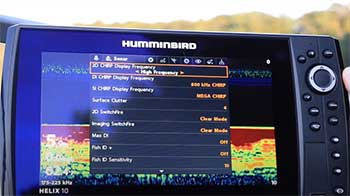When it comes to fish finders, Humminbird has consistently set the bar high. Two key technological advancements of Humminbird are the CHIRP (Compressed High Intensity Radar Pulse) and MEGA Imaging transducers. However, choosing between these two might be challenging.
So, let’s dive deep into the sea of knowledge to understand the differences, pros, and cons of both.
A Brief Comparison Table
| Features | Humminbird CHIRP | Humminbird MEGA Imaging |
| Frequency Range | 28 kHz to 210 kHz | 1.2 MHz (1200 kHz) |
| Imaging Resolution | High | Very High |
| Depth Penetration | Excellent | Good (best in shallow water) |
| Side-to-Side Coverage | Good | Excellent |
| Clarity | High | Very High |
| Target Separation | Excellent | Good |
| Best Suited for | Deep-sea fishing | Shallow water fishing |
| Power Consumption | Standard | Higher |
Introducing Humminbird CHIRP

The CHIRP transducer represents a significant upgrade over traditional fish-finding sonar.
Unlike traditional sonar that sends one frequency at a time, CHIRP sends a continuous sweep of frequencies.
This sweeping technology allows the device to extract more information, providing better target separation and less noise.
Pros of Humminbird CHIRP
- Greater Clarity and Resolution
CHIRP offers superior clarity and resolution compared to traditional sonar. By leveraging multiple frequencies, it can deliver more detailed images of the underwater world.
- Improved Target Separation
A CHIRP sonar is exceptional at distinguishing between closely spaced targets, reducing clutter, and helping anglers identify fish, structure, and the bottom more accurately.
- Better Depth Penetration
CHIRP also excels at depth penetration. This makes it perfect for deep-sea fishing where the seabed might be hundreds of meters below the surface.
Cons of Humminbird CHIRP
- Limited Side Viewing
While CHIRP is excellent at vertical scanning, it has a more limited side view. This can make it less effective in shallower water or when you’re looking for structure off to the sides of the boat.
- Potential for Interference
The wider frequency range can lead to more instances of interference from other electronics or nearby boats also using CHIRP technology.
Also Read: Problems With Lowrance Hook 9.
Exploring Humminbird MEGA Imaging
MEGA Imaging is Humminbird’s latest innovation in fish finding technology. It uses high-frequency sonar (1.2 MHz or 1200 kHz) to produce exceptionally detailed images.
Pros of Humminbird MEGA Imaging

- Exceptional Detail
With the highest frequency range among consumer fish finders, MEGA Imaging offers unprecedented detail, allowing you to see underwater structures and fish with almost photographic clarity.
- Greater Side-to-Side Coverage
MEGA Imaging has a wider beam, providing superior side-to-side coverage. This allows you to see more of what’s under the water around your boat.
Cons of Humminbird MEGA Imaging
- Limited Depth Penetration
High-frequency signals don’t penetrate as deeply as lower frequencies. So, while MEGA Imaging is excellent for capturing details, it is less effective in deep water.
- Requires More Power
High-frequency sonar requires more power to operate, which could mean a shorter battery life for your fish finder.
Key Differences Between Humminbird CHIRP and MEGA Imaging Transducers
Although both the Humminbird CHIRP and MEGA Imaging transducers are advanced fish finding technologies, they have significant differences in terms of their frequency ranges, imaging resolution, depth penetration, and side-to-side coverage.
Let’s explore these differences in more detail.
- Frequency Range
The most significant difference between CHIRP and MEGA Imaging is the frequency range. CHIRP uses a sweep of frequencies, typically from low to high (28 kHz to 210 kHz).
This broad range provides excellent target separation and depth penetration.
On the other hand, MEGA Imaging operates at a very high frequency – 1.2 MHz or 1200 kHz, significantly higher than any CHIRP frequency. This higher frequency produces incredibly detailed and near-photographic images of the underwater world.
- Imaging Resolution
When it comes to imaging resolution, MEGA Imaging’s high-frequency sonar takes the crown. It provides almost photographic clarity, revealing more details about fish, structure, and bottom contour.
It’s like looking at a high-definition photo.
On the other hand, CHIRP offers excellent clarity and resolution, but it can’t quite match the extreme detail level of MEGA Imaging. However, its strength lies in its ability to distinguish between closely spaced targets.
- Depth Penetration
Here, CHIRP has the upper hand. Its sweeping frequency allows for better depth penetration, making it ideal for deep-sea fishing. If you often find yourself fishing in deep waters, CHIRP will serve you well.
MEGA Imaging, due to its high frequency, does not penetrate as deeply. It is more suited for shallower waters where detail is critical, such as when you’re fishing around structures.
- Side-to-Side Coverage
MEGA Imaging has a wider beam, providing superior side-to-side coverage. This wider view allows you to scan a larger area under and around your boat, making it easier to find fish and underwater structures.
In contrast, CHIRP has a more limited side-to-side coverage. While it does an excellent job of scanning vertically, its horizontal scanning is not as wide-ranging as MEGA Imaging.
So, the key differences between Humminbird CHIRP and MEGA Imaging lie in their frequency ranges, imaging resolutions, depth penetration, and side-to-side coverage. By understanding these differences, you can make a more informed choice based on your specific needs and fishing conditions.
Also Read: Comparison of Helix 9 and 10 Fishfinder Transducers.
So, Which One To Pick?
Both Humminbird CHIRP and MEGA Imaging offer unique benefits. CHIRP is an all-rounder, offering excellent clarity, improved target separation, and better depth penetration. It is ideal for deep-sea fishing.
On the other hand, MEGA Imaging offers unparalleled detail and superior side-to-side coverage, making it a game-changer in shallow-water fishing where details matter most.
In the end, the choice between Humminbird CHIRP and MEGA Imaging transducers boils down to your fishing environment and needs. If depth penetration is your priority, CHIRP is your best bet.
However, if you’re after the highest possible detail in shallower waters, MEGA Imaging is the way to go.
Remember, Humminbird’s innovation is ceaseless, and the company is continually working on improving both these technologies. So, always keep an eye out for the latest updates.
Final Thoughts
Understanding the nuances of these technologies is crucial to making an informed decision about your next fish finder. Humminbird CHIRP and MEGA Imaging transducers are both exceptional pieces of technology designed to elevate your fishing experience, each with their own strengths and weaknesses.
Whether you’re a professional angler or a weekend warrior, investing in the right technology can make a significant difference. So, keep your fishing environment and preferences in mind while choosing between these options.
By carefully considering the details we’ve unpacked here, you’re now well-equipped to make an informed decision that will enhance your next fishing adventure. So, gear up, choose wisely, and let Humminbird’s CHIRP or MEGA Imaging take your fishing experience to the next level.
Happy fishing!


